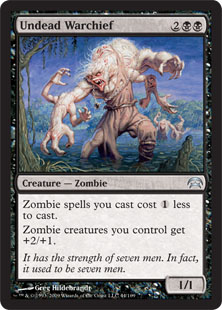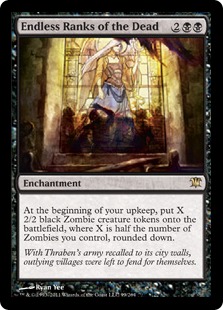
 There are few things I enjoy more than sitting down with a few friends to play Magic. I especially love multiplayer games, and in recent years, Wizards of the Coast has catered several products to the multiplayer audience. Planechase, Archenemy, and Commander formats (the former two of which are represented in the two most recent Duels of the Plansewalkers games) are great ways to play with your buddies. Unfortunately, there is still the problem that plagues most competitive games: somebody loses when anyone wins. The Horde Magic variant was created to avoid this problem.
There are few things I enjoy more than sitting down with a few friends to play Magic. I especially love multiplayer games, and in recent years, Wizards of the Coast has catered several products to the multiplayer audience. Planechase, Archenemy, and Commander formats (the former two of which are represented in the two most recent Duels of the Plansewalkers games) are great ways to play with your buddies. Unfortunately, there is still the problem that plagues most competitive games: somebody loses when anyone wins. The Horde Magic variant was created to avoid this problem.The original source for Horde Magic is Peter Knutson's article at Quiet Speculation. Knutson specifically mentions Left 4 Dead as an inspiration for the format. Magic is full of zombie cards, from all eras of the game. No creature better exemplifies the idea of an unrelenting swarm of monsters. The basic idea is to compose a zombie deck that runs on autopilot, following a few simple rules. The players team up to defend against the undead onslaught, while also attempting to go on the offensive to take the horde down at the source.
 The zombie deck is composed of 100 cards. 60 of these are zombie tokens, like those pictured above. The remainder of the zombie deck is filled with a variety of non-token cards. Building your own zombie deck is part of the fun, but you'll generally want to include more zombies, especially those with interesting effects or zombie-buffing powers, and powerful spells that punish the human opponents. Be sure to use cards that require little to no decision making; for example, cards that make all opponents discard, or sacrifice creatures, are better than those that choose targets. Zombies aren't known for their brains, after all (they are far more concerned with eating them than having them).
The zombie deck is composed of 100 cards. 60 of these are zombie tokens, like those pictured above. The remainder of the zombie deck is filled with a variety of non-token cards. Building your own zombie deck is part of the fun, but you'll generally want to include more zombies, especially those with interesting effects or zombie-buffing powers, and powerful spells that punish the human opponents. Be sure to use cards that require little to no decision making; for example, cards that make all opponents discard, or sacrifice creatures, are better than those that choose targets. Zombies aren't known for their brains, after all (they are far more concerned with eating them than having them).On the zombie deck's turn, flip over cards from the top of the deck until you reveal a non-token card. Put all the tokens revealed this way into play, then resolve the revealed card. (The zombie deck has infinite mana, so no worries about including lands.) Because zombies are hungry all the time, they have haste, and must attack every turn. The human players, who share a life pool of 20 per player, decide how to block, and combat is resolved. Then, the human players all take their turns simultaneously. When damage is dealt to the zombie deck, instead of taking damage, move that many cards from the zombie deck's library to the graveyard. When there are no cards left in the zombie deck library, and no zombies are in play, the game is over, and the human players win.
 The ebb and flow of a game of Hordes Magic is very tense. The default rules give the human players three turns to prepare their defenses, which helps, but the fact remains that the zombies hit fast and hit hard. On average, you can expect one or two zombie tokens, plus another spell or creature, to hit the board each turn. That's bad enough, but sometimes, luck goes against you, and you might turn over many more zombies. Our record so far is flipping eight zombie tokens in a row, which was a dreadful experience for sure! As you plan the best defense, cooperation and compromise are of the utmost importance. It might be necessary to sacrifice one of your own better creatures for the good of the team, for instance. The sense of teamwork in this format is very strong.
The ebb and flow of a game of Hordes Magic is very tense. The default rules give the human players three turns to prepare their defenses, which helps, but the fact remains that the zombies hit fast and hit hard. On average, you can expect one or two zombie tokens, plus another spell or creature, to hit the board each turn. That's bad enough, but sometimes, luck goes against you, and you might turn over many more zombies. Our record so far is flipping eight zombie tokens in a row, which was a dreadful experience for sure! As you plan the best defense, cooperation and compromise are of the utmost importance. It might be necessary to sacrifice one of your own better creatures for the good of the team, for instance. The sense of teamwork in this format is very strong. One of the most enjoyable parts of this format is constructing the zombie deck. You can do a little development and tweaking here, in order to make the deck as tough as you'd like. A 100 card zombie deck is intended for 4 players, so tweaking the numbers for fewer players is a must. A good starting point is taking out 25 cards for each player less than four. My first attempt at a zombie deck was a bit on the weak side, so we adjusted on the fly, and took on the full deck with three players. Adding in more powerful spells like mass creature destruction or discard effects can also make the zombie deck far more challenging. Adding new cards, taking out ineffective ones, and other general fiddling with the zombie deck is quite fun.
One of the most enjoyable parts of this format is constructing the zombie deck. You can do a little development and tweaking here, in order to make the deck as tough as you'd like. A 100 card zombie deck is intended for 4 players, so tweaking the numbers for fewer players is a must. A good starting point is taking out 25 cards for each player less than four. My first attempt at a zombie deck was a bit on the weak side, so we adjusted on the fly, and took on the full deck with three players. Adding in more powerful spells like mass creature destruction or discard effects can also make the zombie deck far more challenging. Adding new cards, taking out ineffective ones, and other general fiddling with the zombie deck is quite fun.If you play Magic, especially in a multiplayer format, you really should give Horde Magic a try. While zombies are probably the most thematic army for a Horde deck, you could just as easily build it around goblins, slivers, dragons, squirrels, or any other favorite creature type. You can even mix in elements from Planechase or Archenemy to change the experience if you like. Playing against a common opponent, and either winning or losing as a team, is a very nice change from the typical, often cutthroat multiplayer game of Magic. Managing to stave off a dangerous swarm of undead attackers is a good time, whether it's on your Xbox 360 or your kitchen table.
by Marc "DjinniMan" Allie
--------------
http://www.co-optimus.com/editorial/1082/page/1/tabletop-co-op-magic-the-gathering-horde-mode.html


No comments:
Post a Comment